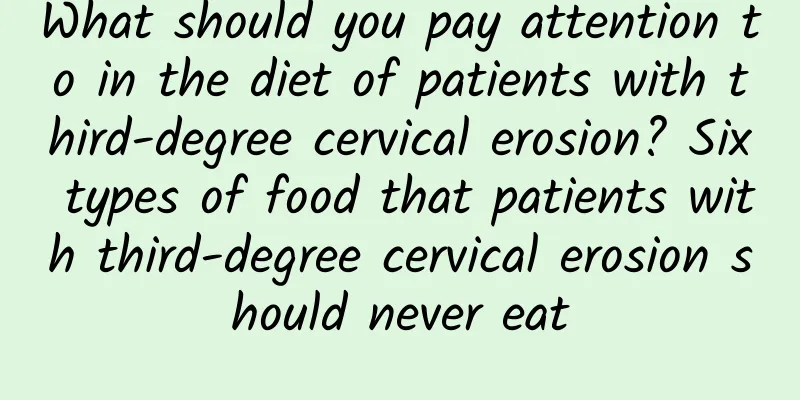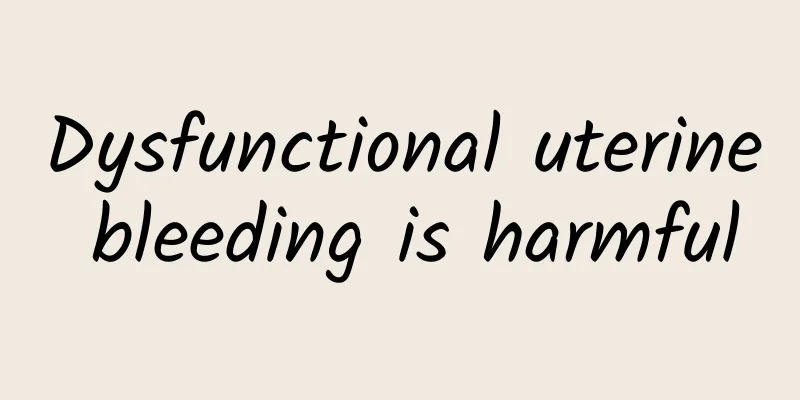What should you pay attention to in the diet of patients with third-degree cervical erosion? Six types of food that patients with third-degree cervical erosion should never eat

|
In life, "Diseases come from the mouth, disasters come from the mouth." is a classic saying, especially for women with third-degree cervical erosion. Eating the right food can be a dietary supplement and is conducive to recovery. Eating the wrong food will affect the treatment effect and make yourself suffer more. So, what should patients with third-degree cervical erosion pay attention to in their diet? 1. Stay away from irritating foods Patients with cervical erosion should eat less irritating foods, such as spicy and sour foods, and try to eat less hot or too cold foods. They should also avoid irritating foods and drinks such as chili peppers, peppercorns, raw onions, raw garlic, and white wine. 2. Avoid eating hair-raising foods Avoid eating irritating foods, such as lamb, beef, fish, lentils, seafood, bamboo shoots, kelp, rooster, eggs, duck, shrimp, goose, pepper, pickles, Sichuan pepper, leeks, coriander, etc. Once eaten, the condition will be aggravated, thus affecting the treatment effect. 3. Avoid spicy food Avoiding spicy food is one of the dietary taboos for cervical erosion. Spicy, warm and irritating foods will aggravate pelvic congestion and inflammation, or cause excessive contraction of the uterine muscles, thereby aggravating the symptoms. 4. Avoid eating seafood products Patients with third-degree cervical erosion must not eat seafood, because seafood is also a prone to infection and can easily worsen the condition. 5. Avoid certain fruit supplements Patients with third-degree cervical erosion should also avoid eating fruit supplements, such as longan, red dates, donkey-hide gelatin, royal jelly and other foods that are hot, coagulant and contain hormones. 6. Avoid foods high in sugar Patients with third-degree cervical erosion should eat a light and delicious diet, eat more vegetables and fruits, and eat less sweets, irritating foods, spicy foods, etc. Ice cream, desserts, sweetened coffee, sugary drinks, etc. are the favorite foods of many women. Long-term consumption of foods with high sugar content will significantly shorten a person's life span. In addition to the possibility of diabetes, women who love to eat snacks dominated by sweets and consume excessive sugar are also prone to gynecological diseases such as vaginitis, pelvic inflammatory disease, and adnexitis. |
<<: How to treat mild cervical erosion in women How to treat mild cervical erosion in women
Recommend
What can't you eat with uterine fibroids? Can patients with uterine fibroids eat hot pot?
What can't you eat with uterine fibroids? Exp...
What are the tests for uterine fibroids?
There are many types of uterine fibroids, and the...
What is painless abortion? How much do you know about it?
Nowadays, there are more and more advertisements ...
Lowering body fat percentage is the key to losing weight! Patented Green Madai to get rid of stubborn fat
If you want to have a slim figure, losing weight ...
What are the drugs for treating uterine fibroids?
If uterine fibroids are not treated in time, it w...
Clinical manifestations and diagnosis of menopause
Menopause is a process that every woman must go t...
How much does it usually cost to have an abortion?
Everyone knows that the cost of abortion is deter...
How to treat functional amenorrhea
How is functional amenorrhea treated? Patients wi...
Common causes of vaginitis in women
Vaginitis, a gynecological disease, can seriously...
Are there any complications of premature ovarian failure?
Are there any complications of premature ovarian ...
What are the symptoms of pelvic inflammatory disease?
Recently, the number of patients with pelvic infl...
Provincial zongzi hygiene inspection by the Food Administration: 29 failed
The Dragon Boat Festival is just a few days away....
What are the common causes of vaginitis?
Vaginitis is one of the most common gynecological...
Will the molar pregnancy survive if it is not treated?
Hydatidiform mole is an abnormal pregnancy that c...
How to diagnose cervical warts in time
Cervical warts have caused great harm to countles...









